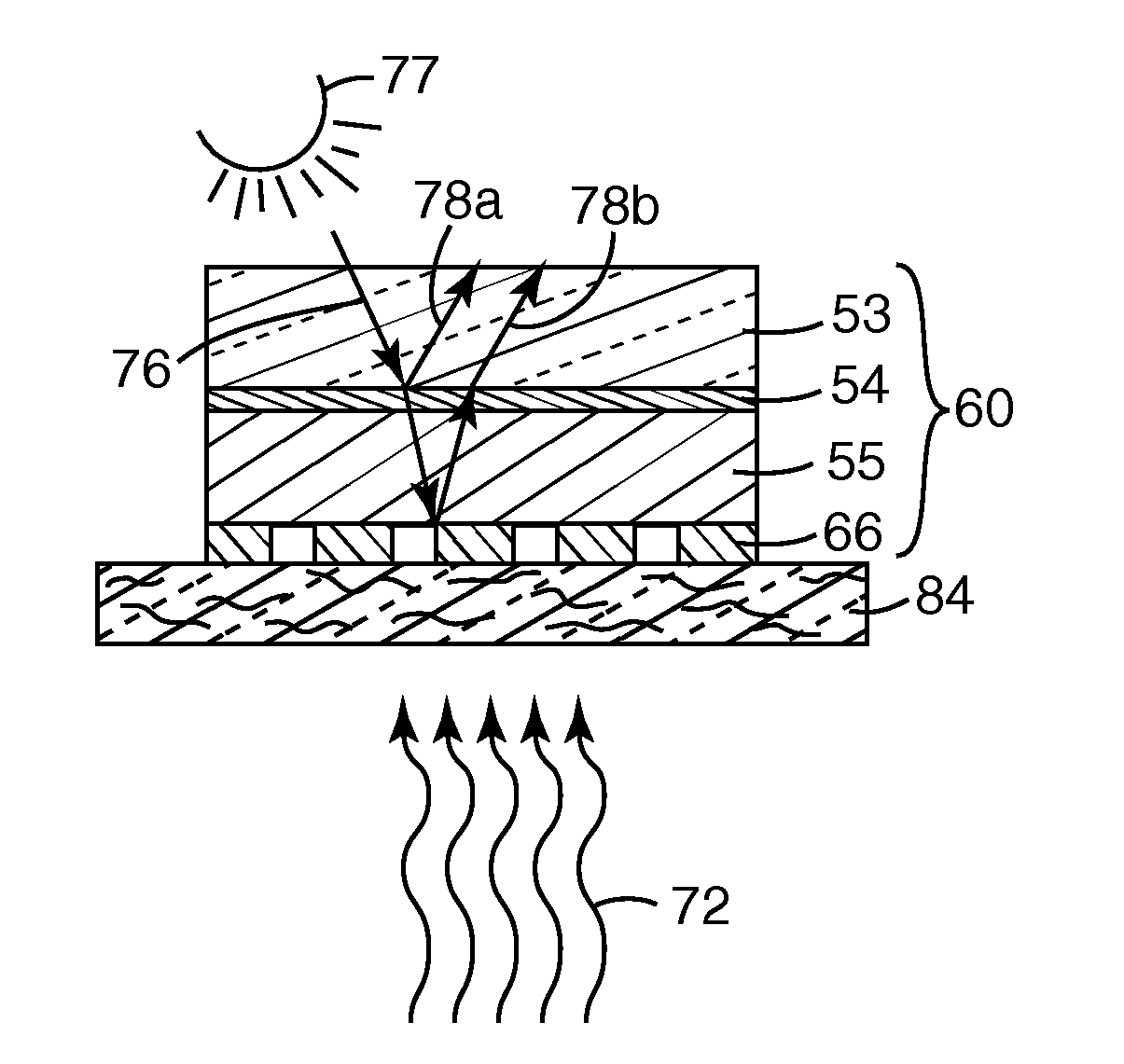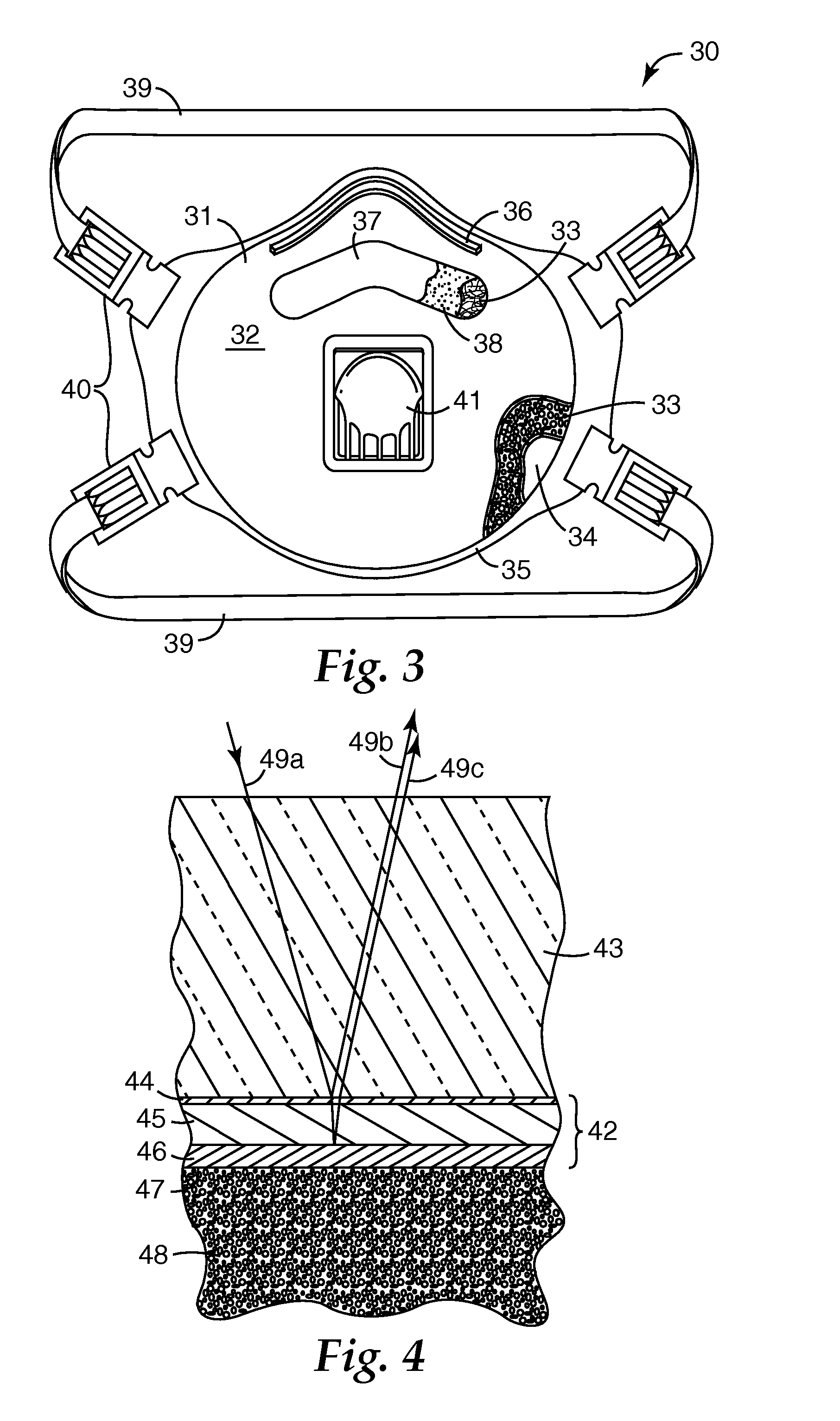Organic Vapor Sorbent Protective Device With Thin-Film Indicator
a protective device and indicator technology, applied in the direction of chemical indicator analysis, optical radiation measurement, instruments, etc., can solve the problems of insufficient sensitivity or sensitivity to one or more substances, and insufficient sensitivity or sensitivity to only one or a few substances. , to achieve the effect of easy use, low cost and easy to see the change of the indicator appearan
- Summary
- Abstract
- Description
- Claims
- Application Information
AI Technical Summary
Benefits of technology
Problems solved by technology
Method used
Image
Examples
example 1
[0071]A multilayer film indicator containing an impermeable semireflective layer, a porous silica detection layer and a vapor-permeable reflective layer was prepared as follows. Glass slides were first sputter coated using a Denton Vacuum Desk II sputter coater equipped with an AuPd (60:40 Au / Pd ratio by mass) target to provide an approximately 5 nm thick semireflective layer. The sputter coating power and coating duration were 35 milliamps and 20 seconds respectively, under a vacuum of 100 millitorr. A poroussilica film was deposited onto the semireflective layer via sol-gel solution dip coating. The silica sol was prepared using a two-step hydrolysis process. In Step 1, 231.6 parts tetraethoxysilane, 195.2 parts absolute ethanol, 17.28 parts deionized water and 0.715 parts 0.07N HCl were combined in a vessel and stirred while heating at 60° C. for 90 min to form a silica sol. In Step 2, 122.97 parts of the Step 1 silica sol, 17.50 parts 0.07N HCl and 5.75 parts deionized water wer...
example 2
[0075]The Example 1 thin-film indicator 60 was evaluated using three different vapor paths. The first vapor path is shown in FIG. 7. An organic vapor-containing air stream 72 flowed across indicator 60 above glass substrate 53. A small piece of woven carbon paper 74 placed against the vapor-permeable aluminum reflective layer 66 allowed a path for organic vapors in air stream 72 to reach porous silica detection layer 55. Incident light rays such as ray 76 from light source 77 were reflected by semireflective layer 54 as first reflected ray 78a and by aluminum layer 66 as second reflected ray 78b. The second vapor path is shown in FIG. 8. FIG. 8 is like FIG. 7 but the organic vapor-containing air stream 72 reached porous silica detection layer 55 through a piece of glass wool 84 placed against vapor-permeable aluminum reflective layer 66. The third vapor path is shown in FIG. 9. FIG. 9 is like FIG. 7 and FIG. 8 but the organic vapor-containing air stream 72 reached porous silica dete...
example 3
[0078]A thin film indicator was prepared using polymers of intrinsic microporosity (PIMs) as the detection layer, and a laser to ablate holes in the reflective and detection layers.
[0079]PIM Polymer Preparation. PIM polymer was prepared from the monomers BC and FA generally according to the procedure reported by Budd et al. in Advanced Materials, 2004, Vol. 16, No. 5, pp. 456-459. 9.0 grams of BC were combined with 5.28 g of FA, 18.0 g potassium carbonate, and 120 milliliters of DMF and the mixture was reacted at 70° C. for 24 hours. The resulting polymer was dissolved in THF, precipitated three times from methanol, and then dried under vacuum at room temperature. A yellow solid product was obtained having a molecular weight (Mw) of 61,800.
[0080]PIM Samples with Laser processed holes. A glass slide was sputter coated with a 5 nm thick layer of Au / Pd, using a DENTON™ Vacuum Desk II sputter coater from Denton Vacuum equipped with an AuPd target with a 60:40 Au:Pd mass ratio. The sputt...
PUM
| Property | Measurement | Unit |
|---|---|---|
| pore size | aaaaa | aaaaa |
| diameter | aaaaa | aaaaa |
| size | aaaaa | aaaaa |
Abstract
Description
Claims
Application Information
 Login to View More
Login to View More - R&D
- Intellectual Property
- Life Sciences
- Materials
- Tech Scout
- Unparalleled Data Quality
- Higher Quality Content
- 60% Fewer Hallucinations
Browse by: Latest US Patents, China's latest patents, Technical Efficacy Thesaurus, Application Domain, Technology Topic, Popular Technical Reports.
© 2025 PatSnap. All rights reserved.Legal|Privacy policy|Modern Slavery Act Transparency Statement|Sitemap|About US| Contact US: help@patsnap.com



